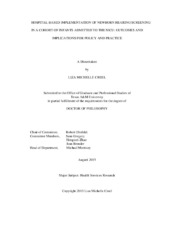| dc.contributor.advisor | Ohsfeldt, Robert L | |
| dc.creator | Creel, Liza Michelle | |
| dc.date.accessioned | 2015-10-29T18:50:23Z | |
| dc.date.available | 2017-08-01T05:37:37Z | |
| dc.date.created | 2015-08 | |
| dc.date.issued | 2015-05-26 | |
| dc.date.submitted | August 2015 | |
| dc.identifier.uri | https://hdl.handle.net/1969.1/155380 | |
| dc.description.abstract | Hearing loss affects approximately 1-3 live births per 1,000. Infants admitted to the NICU are at greater risk of hearing loss than infants in the newborn nursery. Family history, as well as very low birth weight and exposure to certain therapies such as assisted ventilation, are also risk factors associated with hearing loss. Many states mandate newborn screening for hearing loss after birth due to evidence that early diagnosis and intervention improve communication skills and school performance, but following these infants over time can be challenging.
This retrospective study describes temporal trends in primary screening outcomes including screening rates, loss to follow-up, and screen sensitivity and specificity. It also evaluated the likelihood of newborn hearing screening, loss to follow-up, false-positive and false-negative results, as well as hearing loss diagnosis among at-risk infants. Time-to-diagnosis for infants with and without screening was also assessed. The study utilizes a database of births and follow-up encounters for infants born in a large Texas integrated health system between 1996 and 2007.
Most newborn hearing screening program outcomes have improved since implementation in 1996. Outcomes differ by group, with black infants having higher probabilities of being lost to follow-up and receiving a false-positive result, but a lower probability of hearing loss than the overall study population. Infants diagnosed with persistent pulmonary hypertension had a higher probability of a false-negative result. Infants with craniofacial anomalies and neonatal infections have 5-7 times higher probability of hearing loss than those without the diagnoses. The overall incidence of hearing loss among the study population was 5%. Survival estimates demonstrate that infants identified through screening have a higher probability of early diagnosis. Infants with false-negative screens have the same probability of early diagnosis as infants with no screen.
The study findings can inform both policy and practice. Newborn hearing screening leads to earlier diagnosis of infants with hearing loss, but improving targeted follow-up of high risk NICU infants may lead to earlier diagnosis of infants with delayed onset of hearing loss. Community-based providers can monitor high risk NICU infants after discharge for potential hearing loss. | en |
| dc.format.mimetype | application/pdf | |
| dc.language.iso | en | |
| dc.subject | Newborn Hearing Screening | en |
| dc.subject | NICU | en |
| dc.subject | Outcomes | en |
| dc.title | Hospital-Based Implementation of Newborn Hearing Screening in a Cohort of Infants Admitted to the NICU: Outcomes and Implications for Policy and Practice | en |
| dc.type | Thesis | en |
| thesis.degree.department | Health Policy and Management | en |
| thesis.degree.discipline | Health Services Research | en |
| thesis.degree.grantor | Texas A & M University | en |
| thesis.degree.name | Doctor of Philosophy | en |
| thesis.degree.level | Doctoral | en |
| dc.contributor.committeeMember | Gregory, Sean | |
| dc.contributor.committeeMember | Zhao, Hongwei | |
| dc.contributor.committeeMember | Brender, Jean | |
| dc.type.material | text | en |
| dc.date.updated | 2015-10-29T18:50:23Z | |
| local.embargo.terms | 2017-08-01 | |
| local.etdauthor.orcid | 0000-0003-1222-678X | |


